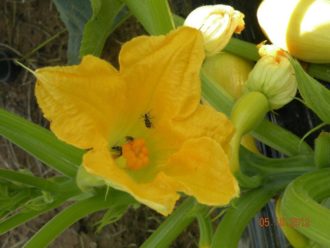DURANT, Oklahoma -- Using row covers on squash protects the vegetable crop from insect pests such as the squash bug, but timing of their removal can impact pollination and subsequent plant yields, according to Oklahoma State University research.
In a two-year study, horticulturist Jim Shrefler analyzed pest and pollinator incidences and measured squash yields using various row cover treatments at three farm locations in Oklahoma. The goal was to determine the best row cover management practices that provided ideal pest protection and the most productive plants.
“Growers are interested in learning what sustainable, effective control options exist to manage squash bugs,” said Shrefler. “Previously published recommendations for using row covers to exclude this insect pest from cucurbit crops leaves growers with questions regarding when to remove the covers.”
Researchers studied five row cover treatments: no row cover and insecticide application; cover rows until plants flower then remove the covers; cover rows until plants flower, wait 2 more weeks, then remove the covers; cover rows until plants flower, remove cover daily in the morning for 1.5 to 2 hours, then recover; and cover rows until plants flower, remove cover daily in the morning for 3 to 4 hours, then recover. The crop was monitored for insect pests, pollinators and fruit production.
Results showed that while the row covers did the job in protecting the plants from the squash bug, yields were low among most treatments, indicating that the row covers impacted the ability for bees to pollinate the plants.
“The row covers prevented the squash bug from accessing the plants. We observed the bugs walking and laying eggs on the external surface of the covers during the trials,” said Shrefler. “But based on the squash yield results, the row covers also prevented the pollination that is needed for fruit set.”
Of the treatments, the ones that employed daily cover removal during morning hours resulted in squash yields comparable to those of the treatment that used only insecticides and no row covers.
The use of row covers in vegetable production is being further evaluated.
Published by the Southern Region of the Sustainable Agriculture Research and Education (SARE) program. Funded by the USDA National Institute of Food and Agriculture (NIFA), Southern SARE operates under cooperative agreements with the University of Georgia, Fort Valley State University, and the Kerr Center for Sustainable Agriculture to offer competitive grants to advance sustainable agriculture in America's Southern region. This material is based upon work that is supported by the National Institute of Food and Agriculture, U.S. Department of Agriculture, through Southern Sustainable Agriculture Research and Education, under sub-award number: OS14-091. USDA is an equal opportunity employer and service provider. Any opinions, findings, conclusions, or recommendations expressed in this publication are those of the author(s) and do not necessarily reflect the view of the U.S. Department of Agriculture.
